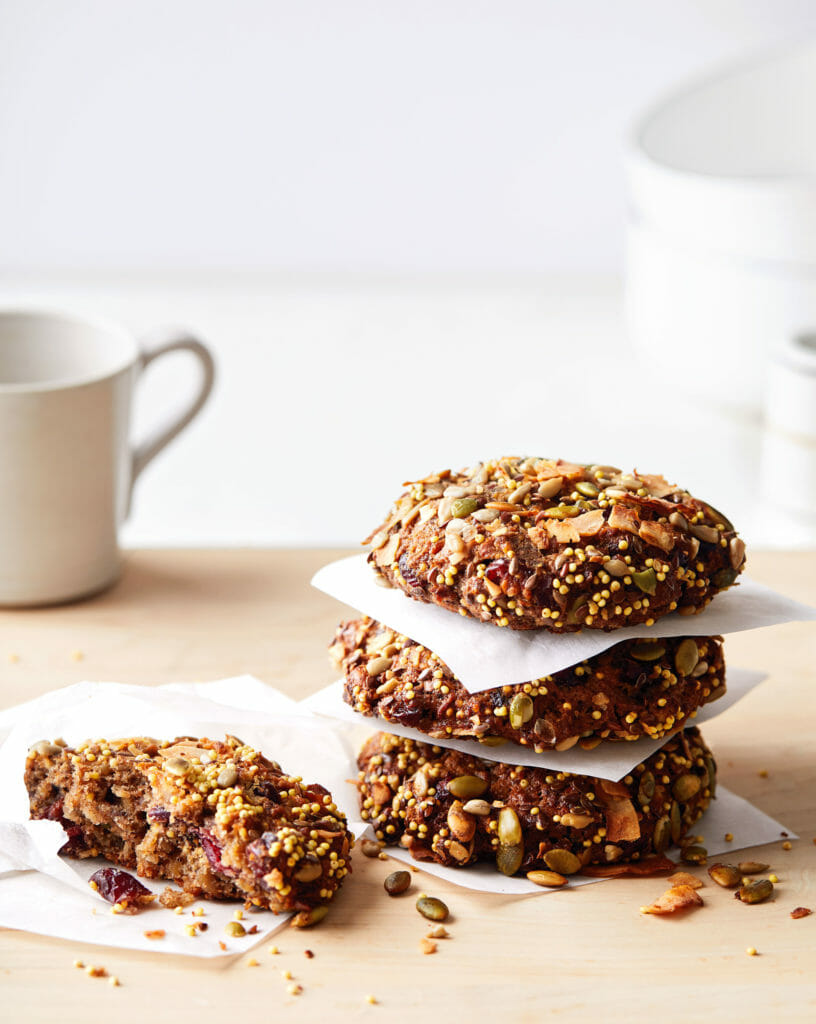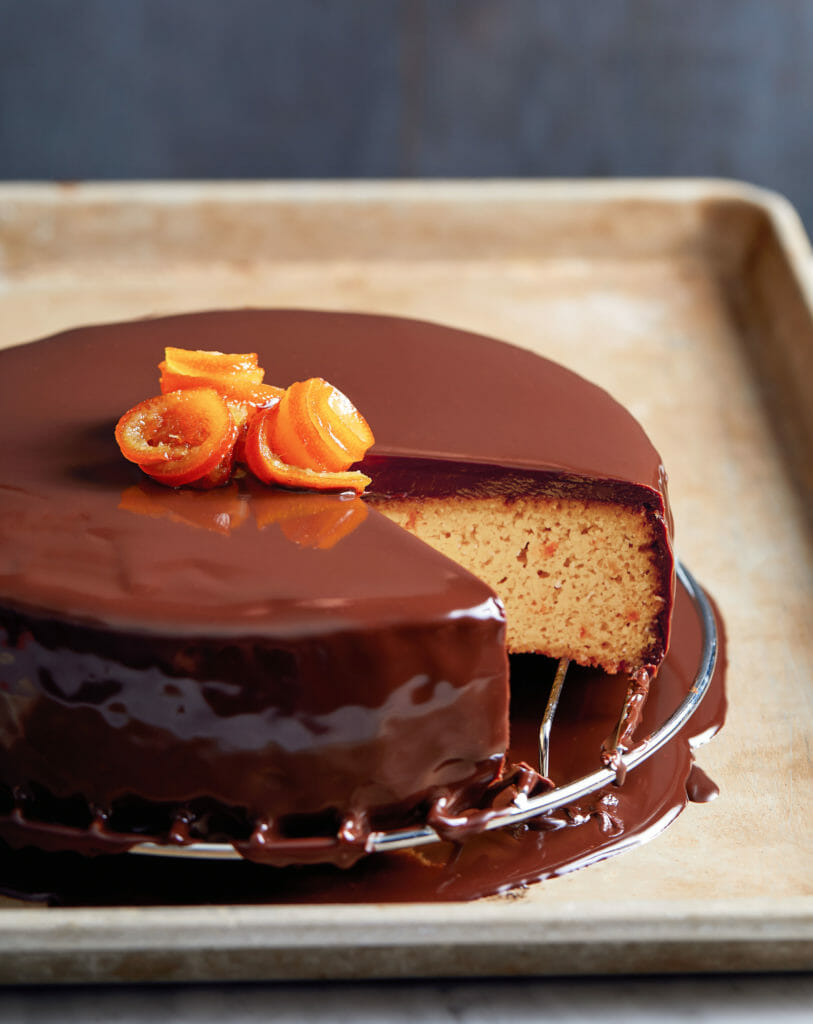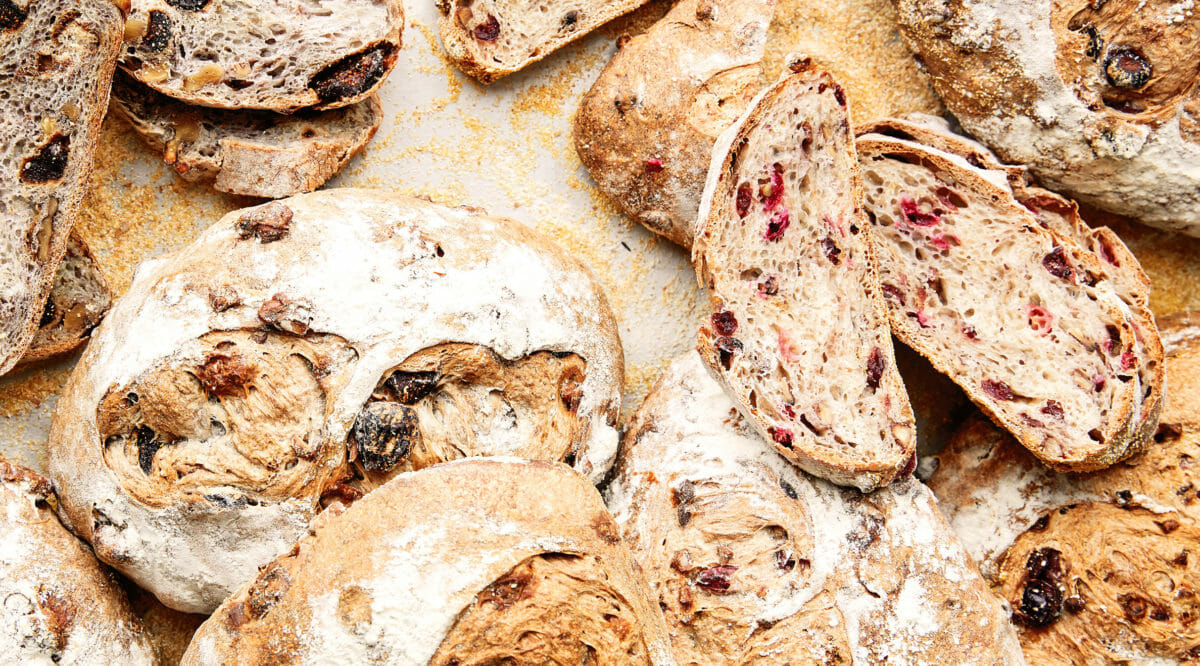Twice a month, our writer cooks from the book and decides if these farm-to-table recipes are worth the investment.

For many, the act of having someone bake for us is the very definition of “pastry love.” But for Joanne Chang, the woman behind Boston’s beloved Flour Bakery, the term has a different definition: to tend lovingly to a display of baked goods to make sure each of them is as enticing as possible. As the title of her new book, Pastry Love (Houghton Mifflin Harcourt; $40), the term does double duty, bringing together a collection of well-loved recipes to share with those around you.
“Pastry” covers everything that a pastry chef might make, from a humble muffin (including some gluten-free options) through to dinner party showpiece desserts, caramels, and a whole section on bread. It opens with an exceedingly helpful “master techniques” section, and it ends with a chapter of Chang’s master recipes (for various doughs, pastry cream, ganache, etc.). The book is almost a journal with thoughtful notes before each recipe. What pulls it out of textbook territory are enticing recipes such as Eggnog Cheesecake with Gingerbread People, and Apple Cider-Miso Caramels.
I am easily seduced by a breakfast cookie, so I attempted Chang’s Nutty Seedy Breakfast Cookies. Melted butter (quite a lot of it), maple syrup, vanilla, eggs and mashed banana are whisked together in one bowl. In another, pepitas, coconut, sunflower seeds, flax seeds and millet are combined, with some set aside. Walnuts, dried cherries and cranberries, whole wheat flour, baking soda and spices are added, along with the wet ingredients. The dough is rested, rolled into balls, dunked in the reserved seed mixture, and baked in a medium oven. The result was definitely not healthy, but it was delicious and lighter than the usual hockey puck-like breakfast cookie.
Pastry Love is thorough in the way that baking books really need to be, but it’s also kind, comforting and, most of all, approachable. Those new to baking will appreciate Chang’s encouraging and rock-steady voice, while experienced bakers will love getting their hands on her tried-and-true creative recipes.
Wendy Underwood tests out cookbooks weekly on Instagram at @kitchenvscookbook.
The following is an excerpt from Pastry Love: A Baker’s Journal of Favorite Recipes (C) 2019 by Joanne Chang and reproduced with permission from Houghton Mifflin Harcourt. All rights reserved.
Nutty Seedy Breakfast Cookies
MAKES 18 TO 20 COOKIES
Eating cookies for breakfast might seem like a ruse your kids try to pull on you to get out of eating their Wheaties. But when we created this recipe, we made sure it was full of whole grains and seeds and fruits and nuts and that it was wholesome enough for you to feel good about how you were starting off your morning. Don’t be daunted by the number of ingredients. While it most likely will require a trip to the grocery store, you’ll end up with a pantry nicely stocked with useful staples to encourage your whole grain baking even further. This cookie has become one of my favorite ways to start the morning, and I think it will become one of yours, too.
3/4 cup/90 grams walnuts, roughly chopped
1 cup/2 sticks/225 grams unsalted butter
1/2 cup/170 grams maple syrup
1 teaspoon pure vanilla extract
3 large eggs (about 150 grams), at room temperature
1 ripe banana, thoroughly mashed (about 1/3 cup/100 grams)
3/4 cup/100 grams raw unsalted pepitas (shelled pumpkin seeds)
3/4 cup/40 grams unsweetened flaked coconut
1/2 cup/45 grams raw shelled sunflower seeds
1/2 cup/50 grams flaxseeds
1/4 cup/50 grams millet
11/2 cups/150 grams rolled oats
1 cup/120 grams dried cranberries
2/3 cup/100 grams whole wheat flour
1/2 cup/100 grams dried cherries
1 teaspoon baking soda
1 teaspoon kosher salt
1/2 teaspoon ground cinnamon
1/4 teaspoon freshly grated nutmeg
Preheat the oven to 350°F and place a rack in the center of the oven. Place the walnuts on a baking sheet and toast for 6 to 8 minutes, until they are light golden brown and fragrant. Remove from the oven and set aside to cool.
Melt the butter, then place it in a medium bowl. Whisk in the maple syrup and vanilla until well combined. Whisk in the eggs and banana until the mixture is totally homogeneous. (The banana needs to be completely mashed so it whisks in smoothly.)
In a large bowl, stir together the pepitas, coconut, sunflower seeds, flaxseeds, and millet. Remove 1/2 cup/about 50 grams of the mixture and set it aside for topping the cookies. Add the walnuts, oats, cranberries, flour, cherries, baking soda, salt, cinnamon, and nutmeg to the bowl and stir well to combine. Make a well in the center and pour in the butter mixture. Stir well to combine — the dough will be more like a soft batter than a stiff cookie dough. Cover the bowl and refrigerate for at least 30 minutes or up to overnight, to allow the grains to absorb the liquid and firm up the batter.
When ready to bake the cookies, preheat the oven to 350°F. Line a baking sheet with parchment paper or butter it.
Wet your hands and use them to scoop about 1/4 cup of the dough from the bowl. Roll the dough into a rough ball, dip the top of the ball into the reserved seed mixture, and plop it seed side up on the prepared baking sheet. Repeat to form the remaining dough. Press the cookies down with the palm of your hand to make them flat. Bake for 20 to 22 minutes, rotating the baking sheet midway through the baking time, until the cookies are golden brown on the edges and firm when you press them in the middle.
Remove from the oven and let cool on the baking sheet on a wire rack.
Cookies can be stored in an airtight container at room temperature for up to 2 days.
Orange-Almond Pudding Cake with Chocolate Ganache
MAKES ONE 8-INCH CAKE, TO SERVE 8 TO 10
I first fell in love with this cake while spending an unforgettable weekend in the Ottolenghi pastry kitchens in London with two of my pastry chefs. Yotam Ottolenghi’s talented army of pastry cooks churned out endless platters of stunning pastries, each of which looked more delectable than the last. This supremely moist and orangey cake was sitting on a counter half eaten, and Paula, one of the pastry chefs, saw me eyeing it. “Oh my, eat it, eat it all!” She grabbed a few forks for me and my team, we descended on this cake, and it disappeared in seconds. Not only is this cake gluten-free, but it’s also made without any butter or oil. Yotam generously shared his recipe; I dress it up by double-glazing it with an orange-infused chocolate ganache to create a shiny mirrored surface.
Candied Oranges (page 318)
5 large eggs (about 250 grams), at room temperature
1 cup/200 grams sugar
1/2 teaspoon pure vanilla extract
21/4 cups/225 grams almond flour
1 teaspoon baking powder
1/2 teaspoon kosher salt
Chocolate-Orange Ganache (page 318), melted and cooled but still pourable
Make and drain the candied oranges. Set aside 2 or 3 pretty slices for garnish on the cake. Finely chop the rest and set aside separately.
Preheat the oven to 300°F and place a rack in the center of the oven. Line the bottom of an 8-inch cake pan with a parchment paper circle (see page 23), or butter the pan liberally. Set it aside.
In a stand mixer fitted with a whisk attachment, whip the eggs and sugar on medium-high speed until frothy, about 2 minutes. Add the chopped candied oranges and vanilla and whip to combine. Stop the mixer and scrape the sides and bottom of the bowl, as well as the whisk. Whip again for a few seconds. Add the almond flour, baking powder, and salt and whip on low to combine. Stop the mixer and scrape again. Continue to mix until the batter is homogeneous.
Scrape the batter into the prepared pan. Bake for 1 hour 20 minutes to 1 hour 30 minutes, rotating the cake pan midway through the baking time, until the cake springs back when you poke it in the middle and is firm to the touch, and a cake tester inserted into the middle of the cake comes out clean. Remove the cake from the oven and place the pan on a wire rack to cool.
While the cake is baking, make the ganache and set it aside to cool.
When the cake is entirely cool, run a knife around the edges of the cake, pop the cake out of the pan onto a flat plate, and remove the parchment. Turn the cake right side up on a wire rack placed over a baking sheet. Pour about half the ganache over the entire cake, using an offset spatula to coat the sides evenly. Place the cake in the fridge, still on the wire rack, to allow the ganache t set for at least 15 minutes.
Pour a second coat of ganache over the cake. Let the ganache set for at least 30 minutes. Place the cake on a serving platter. Cut into the orange slices and twist them into spirals; decorate the center of the cake with them. Serve.
The cake can be stored in an airtight container at room temperature for up to 3 days.
Candied Oranges
MAKES ABOUT 1½ CUPS/340 GRAMS
2 navel oranges
3 cups/600 grams sugar
Slice the ends off the oranges, then slice the oranges crosswise about 1/4 inch thick.
In a medium saucepan, combine the sugar and 4 cups/960 grams water and bring to a boil. Add the orange slices to the sugar syrup and reduce the heat to very low.
Let the oranges simmer in the syrup for 2 to 3 hours, until they are translucent and the syrup has the consistency of maple syrup, gently stirring occasionally to move the top slices to the bottom of the syrup. Test for doneness by removing an orange slice from the syrup and biting into it; careful — it will be hot! The rind should be completely soft and sweet and the syrup should be very thick. Remove the saucepan from the heat and let the oranges cool completely in their syrup.
The oranges can be stored in their syrup in an airtight container in the refrigerator for up to 2 weeks. Drain before using.
Chocolate-Orange Ganache
MAKES ABOUT 1¼ CUPS
3/4 cup/180 grams heavy cream
1 tablespoon grated orange zest (about 1 large orange)
6 ounces /170 grams semisweet or bittersweet chocolate, roughly chopped
In a small saucepan, heat the cream and orange zest over medium-high heat until just before it comes to a boil, when small bubbles collect along the sides of the pan. Turn off the heat and let the cream sit for 30 minutes to allow the orange to infuse into it.
Place the chocolate in a medium metal or heatproof glass bowl. Return the cream to just under a boil, then strain it through a fine-mesh strainer directly over the chocolate. Let it stand for 30 seconds. Slowly whisk the chocolate and cream together until the chocolate is completely melted and the ganache is smooth.
The ganache can be stored in an airtight container in the refrigerator for up to 2 weeks.
Cranberry-Pecan Bread
MAKES 2 LOAVES
For ten months of the year we make a barely sweet raisin-pecan bread that is an homage to the nutty, hearty raisin-pecan bread from Amy’s Bread in New York City. I spent a very short time at Amy’s early in my career, learning the very basics of mixing, shaping, proofing, and baking bread. The owner, Amy Scherber, was — and still is — an inspiration to me, not only because of her fabulous bread that is beloved across New York, but also because she is kind, gracious, direct, and as generous a person as you’ll ever meet. When I’m in New York I always stop by one of her bakeries to get a few loaves to bring back to Boston. During the winter holidays we change up our standard raisin-pecan for a cranberry-pecan to celebrate the arrival of cranberry season. We knead dried cranberries into the dough and also throw in a generous handful of fresh cranberries. The combination of the sweet chewy dried with the tart juicy fresh makes this a loaf we look forward to all year long.
Note that this takes two days to make, so be sure to plan ahead.
Sponge for Cranberry-Pecan Bread (page 148), at room temperature
1 cup plus 2 tablespoons/270 grams water, at body temperature (when you stick your finger in it, it does not register as either warm or cold)
2 cups/280 grams all-purpose flour
11/2 cups/225 grams high-gluten bread flour
1/4 teaspoon active dry yeast
1/4 cup/85 grams honey
21/4 teaspoons kosher salt
1 cup/100 grams pecan halves, toasted (see page 29)
3/4 cup/90 grams dried cranberries
1 cup/100 grams fresh cranberries, roughly chopped
1/4 to 1/2 cup cornmeal, for the baking sheet
The day before you will be making this bread, make the sponge. Two hours before making the bread, remove the sponge from the fridge.
In a stand mixer fitted with a dough hook attachment or by hand in a large bowl with a wooden spoon, mix the water, all-purpose flour, bread flour, yeast, and sponge for about 2 minutes, until all the ingredients are combined and you have a shaggy, stiff dough. (To prevent the flour from flying out of the mixer bowl, turn the mixer on and off several times until the flour is mixed into the liquid and then keep it on low speed.) Cover the bowl with a piece of plastic wrap and let sit for about 10 minutes. (This is called an autolyse; it allows the water to hydrate the flour, which makes for better mixing down the road.)
Add the honey and salt to the dough and mix on medium-low for 6 to 8 minutes, until the dough is smooth. If it does not come together, let it sit for a few minutes to allow the flour to be absorbed into the dough more, then mix again for a few minutes. The dough should be somewhat sticky but still smooth, and have the texture of an earlobe (as strange as that sounds). If it’s stiffer than this, add a few tablespoons water, or if it’s looser than this add a few tablespoons all purpose flour, and mix until incorporated. Don’t add more flour unless it’s really soupy. If you’re mixing by hand this process will take at least 15 minutes of active kneading. Constantly knead, push, and fold the dough over itself, picking it up from time to time and slapping it onto the counter to incorporate all the ingredients and help develop the dough’s structure.
Add the pecans, dried cranberries, and fresh cranberries and mix on low for another 3 to 4 minutes, until the nuts and cranberries are all completely and evenly distributed within the dough. You may need to stop the mixer a few times to pull off any dough that has gathered around the hook or on the sides of the bowl. If you are mixing and kneading by hand, it will take at least 10 minutes to incorporate these ingredients.
Lightly oil a clean large bowl, remove the dough from the mixer bowl, and place it in the oiled bowl.
Cover it with an oiled piece of plastic wrap or a damp lint-free towel. Place it in a draft-free warm place (78° to 82°F is ideal; an area near the stove or an oven with only the pilot light on is good) for 2 to 3 hours. The dough will rise a little bit but not a lot, and will feel a little loose and relaxed and somewhat sticky.
Generously flour your hands and work surface and turn the dough out of the bowl. Divide the dough in half with a sharp chef’s knife or bench scraper. Shape each half into a rough square. Working with one half at a time, bring the upper right and left corners of the dough to the center of the square and then fold over the top of the dough to meet the corners in the center. Now hold the top part of the dough in both hands, cradling the folded-over part with your fingers, and line up your thumbs in the center of the dough along the seams in the middle. Push at the center of the dough at the seam, nudging away from you with your thumbs to create a taut surface at the outside of the dough. Cup the outer part of the dough in your fingers again and bring your thumbs against the seam again as you nudge the dough away from you. Roll your hands toward you to create more surface tension on the dough as you roll it down to the bottom of the square. Continue nudging and rolling until you have a long loaf that is fat in the middle and tapered at the ends like a football. (At this point you can store the shaped loaves on a baking sheet or flat plate, covered lightly with plastic or a lint-free towel, in the fridge overnight. Remove the next day and proceed as directed.)
Generously sprinkle a baking sheet with cornmeal to keep the loaves from sticking to it. Place the shaped loaves seam side down on the baking sheet, at least 3 inches apart. Cover them loosely and completely with plastic wrap or a lint-free towel and let them sit at room temperature for 2 to 3 hours, until the dough has loosened up and seems relaxed. It won’t pouf up too much but it will seem much softer.
Preheat the oven to 400°F and place racks in the center and bottom third of the oven. (It’s very important to make sure the oven comes to temperature before you place the bread inside! The heat from the oven ensures that your loaves will get enough oomph to rise and grow.) Sprinkle the tops of the loaves with 2 to 3 tablespoons flour. Slash the loaves on top with a knife, lame, or razor blade (see page 27) and place the baking sheet on the center rack. Place a rimmed baking sheet or shallow baking pan filled with about 2 cups water on the rack underneath the bread. (The steam from the water will create a nice moist atmosphere, allowing your bread to grow.) Bake for 30 to 35 minutes, rotating the baking sheet with the bread midway through the baking time, until the bread is dark golden brown on top and makes a hollow sound when you thump it on the bottom.
Let cool for at least 1 hour, directly on a wire rack.
The bread can be stored in a paper bag at room temperature for 2 to 3 days. (Plastic seals the air out and keeps the bread from breathing, so it can get too soft.)
Sponge for Cranberry-Pecan Bread
MAKES ABOUT 11/4 CUPS/380 GRAMS
1 cup/140 grams all-purpose flour
1/8 teaspoon active dry yeast
Stir together the flour, 1 cup/240 grams room temperature water, and the yeast until well mixed and sloshy. Cover and leave out at room temperature for at least 4 hours or up to 8 hours.
Stir the sponge, cover, and refrigerate overnight. Pull it out of the fridge 2 hours before using to bring it back to room temperature.



Thank you!
Hi. I’m making your cranberry pecan bread. It mentions pages of a cookbook I assume in the recipe. Can you tell me whose or name of the cookbook. Thank you.